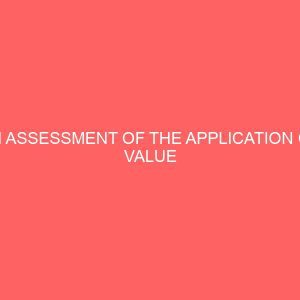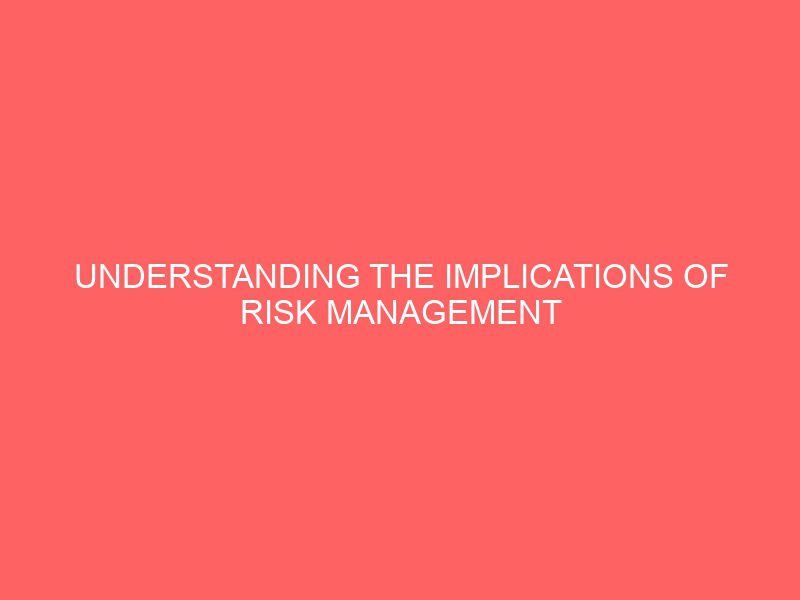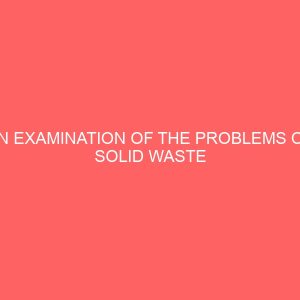Description
CHAPTER ONE
INTRODUCTION
1.1 Background of the Study
This research is on understanding the implications of risk management on performance of selected federal health institutions in south east, Nigeria. Risk management began to be studied after World War II. Several sources (Crockford, 1982; Harrinton and Neihaus, 2003; Williams and Heins, 1995) date the origin of modern risk management to 1955-1964. Snider (1956) observes that there were no books on risk management at the time, and no university offer courses in the subject. The first two academic books were published by Mehr and Hedges (1963) and Williams and Hems (1964). Their content cover pure risk management, which excluded corporate financial risk. Risk management, has long been associated with the use of market insurance to protect individuals and companies from various losses associated with accidents (Harrington and Neihaus, 2003). New forms of pure risk management emerged during the mid-1950s as alternative to market insurance when different types of insurance coverage became very costly and incomplete. Several business risks were costly or impossible to insure. During the 1960s, contingent planning activities were developed, and various risk prevention or self-protection activities and self-insurance instruments against some losses were put in place. Protection activities and coverage for work-related illness and accidents also arose at companies during this period (Harrington and Neihaus, 2003). The use of derivatives as instruments to manage insurable and uninsurable risk began in the 1970s, and developed very quickly during the 1980s. It was also in the 1980s that companies began to consider financial management or risk portfolios. Financial risk management has become complementary to pure risk management for many companies. Financial institutions, including banks and insurance companies, intensified their market and credit risk management activities during the 1980s. Operational risk and liquidity risk management emerged in the 1990s (Harrington and Neihaus, 2003). International regulation of risk also began in the 1900s. Financial institutions developed internal risk management models and capital calculation formulas to protect themselves from unanticipated risks and reduce regulatory capital. At the same time, governance of risk management became essential, integrated risk management was introduced, and the first risk manager positions were created (Harrington and Neihaus, 2003).
The concept of risk management has been used in banking and insurance services since the early 1970’s. Risk management has been an accepted practice in industries in the West since the 1900s and in hospitals in the U.S. since the mid-1970s. However, the activities related to risk management have been in place for decades without the specific name of “Risk Management.” The term risk management in the curriculum of postgraduate studies in hospital administration in Asian countries is almost absent. Yet, the graduates of these postgraduate programs will be at the helm of the hospital industry. They will have little or no appreciation of the critical importance of the continuing process of risk management in the delivery of quality care and sustainability of the hospital in the long run. Risk management activities were inducted into the health care industry in response to the growing national malpractice insurance costs (Woodfin, 2012). Silvers (2005:2) states that “risk management is the art and science of planning, assessing, and handling future events to ensure favourable outcomes and the act or practice of dealing with risk”. Silvers (2005) cited in O’Toole, (2002) stresses that there is an increase in risk management planning by event stakeholders such as government agencies, insurance companies and sponsors. Generally speaking, risk management is the process to protect the assets and minimize financial loss to the organization. Managing risk is a proactive function. It is taking action to reduce the frequency and severity of unexpected incidents, reduce the impact of legal claims, and promote high reliability performance, system design, and the uniqueness of each patient exposes the organization to the potential for liability. Risk management (RM) is a concept which is used in all industries, from IT related business, automobile or pharmaceutical industry, to the construction sector. Each industry has developed their own RM standards, but the general idea of the concept usually remain the same regardless of the sector. Risk is an essential part of business because firms cannot operate without taking risks. Risk is commonly associated with uncertainty, as the event may or may not occur. Risk implies exposure to uncertainty or threat (Kannan and Thangavel, 2008). Organizations operate in a web of risks which span from the cluster of natural catastrophes, failures related to human acts, breach of security, financial turmoil, unsteady business environments and project failures. An organization needs to understand its mission and articulate it clearly. This makes it easier to recognize the risks associated with the mission. Once an organization identifies its mission, it can begin its risk assessment by listing the possible risks that threaten the business with the aim of identifying high priority risks and focusing on those first (Mehr and Hedges, 1963). Risk management is generally a part of other management systems such as quality, environmental or work environmental management systems. Some core values are common in many quality and environmental management systems viz. the commitment of all employees, customer focus, management commitment, focus on process, continuous improvement and fact-based decisions. Risk management is a crucial part of the total project management system regardless of the focus on quality, environment or work environment (Kannan and Thangavel, 2008). Risk management is viewed as a corner stone of good corporate governance and therefore results in better service delivery, more efficient and effective use of scarce resources and better project management (Collier et al., 2007). It has to do with identification, analysis and control of such risks that threaten resources, assets, personnel and the earning capacity of a company (Dorfman, 2007). According to Dorfman (2007), risk management is the logical development and implementation of a plan to deal with potential losses. It is important for an organization to put in place risk management programmes so as to manage its exposure to risks as well as protect its assets. The essence is to prepare ahead of time on how to control and finance losses before they occur. Dorfman continues to say that risk management is a strategy of pre-loss planning for pre-loss resources. Risk management is: “a process of understanding and managing the risks that the entity is inevitably subject to in attempting to achieve its corporate objectives. For management purposes, risks are usually divided into categories such as operational, financial, legal compliance, information and personnel. One example of an integrated solution to risk management is enterprise risk management” (CIMA, 2005). Enterprise Risk Management deals with risks and opportunities affecting value creation or preservation, defined as “a process, effected by an entity’s board of directors, management and other personnel, applied in strategy setting and across the enterprise, designed to identify potential events that may affect the entity and manage risks to be within its risk appetite, to provide reasonable assurance regarding the achievement of entity objectives” (COSO, 2004).
The issue of risk management strategy is also very crucial and fundamental to effective risk management. This is because it provides barriers against an accumulation of exposures inherent in on-going business activities (Chorafas, 2008). Companies need risk management strategies in order to be successful at risk management. It helps management to identify and decide which risks to avoid, control, transfer to another party such as an insurance company or which risk to tolerate, that is accepting some or all the consequences of a particular risk. The focus of good risk management is the identification and treatment of these risks. Its objective is to add maximum sustainable value to all the activities of the organization. This activity must also be realistic, practical and cost effective (Woodfin, 2012). The role of risk management is to identify and evaluate the risks faced by the firm, to communicate this risk to senior management and to monitor and manage these risks in a way that ensures that firm bears only the risks its management and board want exposure to. It helps companies to minimize the risks and maximize the profits at the time (Jungmoo, 1999). organizations are facing an increasing number and a greater variety of risks and there is growing recognition that risk must be managed with the total organization in mind. All organizations are required to have a more practical approach to dealing with risk that goes beyond the statistical and analytical to future scenario and planning (jolly, 2003). Companies that understand risks better than their competitor are in a very powerful position to leverage risk to a competitive advantage. Greater knowledge of risks delivers the competitor and to manage risk at the lowest cost (Davenport and Bradley, 2000). Furthermore, the recent economic volatility has given risk management a new focus and eminence. Successful firms’ are able and willing to effectively integrate risk management at all levels of management process from strategy to success. Risk management is an invaluable tool for managing uncertainty associated with business. Business enterprises have always practice some forms of risk management, implicitly or explicitly (Meulbroek, 2002). The concept of risk management is, therefore, not so new because risk management techniques like: risk reduction through safety; quality control and hazard education; alternative risk financing; and insurance, including self-insurance and captive insurance, have been in existence for a long time (Doherty, 2000).
1.2 Statement of the Problem
Risk is inherent in every economic activity and every organization has to manage it according to its size and nature of operation because without risk management no organization can survive in the long run. This is because businesses today are faced with far greater challenges than before due to the fact that economical, technological and legal interdependence are becoming more prevalent and pronounced. It would be assumed that risk management systems will vary from organization to organization based on their size or industry sector. It is therefore logical to assume that every business organization has put in place a strong risk management structure and internal control systems to help achieve its goals. These are fundamental to the successful operation and day-to-day running of a business and assist a company in achieving its objectives. Risk may affect many areas of activity, such as strategy, operation, finance, technology and environment. In terms of specifics, it may include, loss of key staff, substantial reductions in financial and other resources, severe disruptions to the flow of information and communication, fires or other physical disasters, leading to interruptions of business and or loss of records. More generally, risk also encompasses issues such as fraud, waste, abuse and mismanagement. Regrettably, organisations in Nigeria have been hampered by pitfalls in traditional approaches to risk management, as risk management is rarely undertaken in a systematic and integrated manner across firms. Traditional risk management views risk as a series of single and unrelated elements where individual risks are categorised and managed separately (Wolf, 2008). The major deficiency of traditional approach to risk management is the narrow focus on threats, rather than focusing on both opportunities and threats. The holistic approach to managing a firm’s risks differs substantially from historical practice, as typical firm tends to aggregate risk (effective risk management), rather than isolating them (traditional risk management) In terms of risk, hospitals are a relatively hazardous working environment for both patients and staff. Hospital staff must continuously deal with adverse events and numerous potential risks relating to surgery, anaesthetics and patient transfers: for example, wound infections, medication errors, wrong-site surgery. The relatively high risk of unsafe situations makes the hospital sector an important setting for an assessment of various approaches to Risk Management. Effective clinical risk management involves the implementation of operational procedures and supports which are based on agreed values and principles. In hospitals, the employees and clients are exposed to varied kinds of hazards and diseases. Therefore failure to institute adequate risk management measures in place by management to protect employees and patients from these hazards and risks will lead to avoidable death and ultimately lead to loss of staff. Inadequate training on acceptance and compliance risk management measures, also hinder its effectiveness. In fact, risk management in the organisations have to be everybody concern but on the contrary, this is not the case in most organisations there is lack of cooperation between management and employees in making risk management issues effective. In today networked and complex worlds, health institutions face challenges, to identify the risk and opportunities in their business environment, they need a more comprehensive and holistic view of the risks for their business milieu, but for health institutions to survive in this turbulent environment, risk management is the key, but if any health institution fail to practice a comprehensive risk management they are bound to experience increase in death rate of patients, system failures, increase in contagious disease, decline profits and productivity, information security breaches, internal fraud, privacy violation, regulatory non-compliance and these will bring total collapse of the system. Thus the study focuses on the assessing implications of risk management on performance of selected federal health institutions in south east, Nigeria.
1.3 Objectives of the Study
The main objective of this study is to assess the implications of risk management on performance of federal health institutions in south east, Nigeria. The specific objectives were to:
| i | To determine the extent to which risk identification affects organizational |
| productivity in selected federal health institutions | |
| ii | To ascertain the extent of the relationship between risk assessment and creativity |
| in selected federal health institutions | |
| iii | To determine the effect of risk response strategy on innovation in selected federal health institutions |
| iv | To determine nature of the relationship between risk management and |
| organizational effectiveness in selected federal health institutions | |
| v | To ascertain the extent at which internal environment affects organizational |
| growth in selected federal health institutions |
1.4 Research Questions
With the above objectives in focus, the study seeks to find answers to the following
questions.
- To what extent does risk identification affect organizational productivity in selected federal health institutions?
- What is the extent of the relationship between risk assessment and creativity in selected federal health institutions?
- What is the effect of risk response strategy on innovation in selected federal health institutions?
- What is the nature of the relationship between risk management and organizational effectiveness in selected federal health institutions?
- To what extent does internal environment affect organizational growth in selected federal health institutions?
1.5 Hypotheses
These hypotheses were proposed for the study
- Risk identification significantly affects organizational productivity in selected federal health institutions.
- There is a significant relationship between risk assessment and creativity in selected federal health institutions.
- Risk response strategy has a significant effect on innovation in selected federal health institutions.
- There is a positive relationship between risk management and organizational effectiveness in selected federal health institutions.
- Internal environment significantly affects organizational growth in selected federal health institutions
1.6 Significance of the Study
The study is significant because: All health institutions in Nigeria will benefit from this work, the study will educate them on how to identify risk and manage risk. The study will serve as a base and framework for future researchers to carry out further studies The study will be of great importance to risk managers, to know how to carry out risk assessment which will help them to be proactive
1.7 Scope of the Study
The study focuses on the Concept of risk management, Reasons for risk management, Problems of risk management, Process of risk management, Critical success factors for effective risk management, Categories of risk management and Rationale of risk management. However, the study will be carried out in the five selected federal health institutions in Southeast Nigeria: Federal Health Centre, Umuahia; Federal Health Centre, Owerri ; University of Nigeria Teaching Hospital Enugu; Nnamdi Azikwe University Teaching Hospital Awka and Federal Teaching Hospital, Abakaliki. The study will cover a time range of 2008 to 2013..
1.8 Operational Definitions of Terms Risk: This is defined as a characteristic of a situation, action, or event in which a number of outcomes are possible, the particular one that will occur is uncertain, and at least one of the possibilities is undesirable (Yoe, 2000).
Uncertainty: This is a state of having limited knowledge where it is impossible to exactly describe the existing state, a future outcome, or more than one possible outcome (knight, 2012).
Risk Management: This refers to the process by which managers satisfy these needs by identifying key risks, obtaining consistent, understandable, operational risk measures, choosing which risks to reduce, which to increase and by what means, and establishing procedures to monitor resulting risk positions (Bessis, 2002),
Health Institution: This means a public or non-profit organization within this state that provides health care and related services, including but not limited to the provision of inpatient and outpatient care, diagnostic or therapeutic services, laboratory services, medicinal drugs, nursing care, assisted living, elderly care and housing, including retirement communities, and equipment used or useful for the provision of health care and related services (http://www.oregonlaws.org.)
Risk Analysis: This is a component of the risk management process, deals with the causes and effects of events which cause harm (Estate Management Manual, 2002).
Risk Identification: This is the process of determining which risk might affect the project (Rochart, 1979).
Business Risk: This include all the risks that happen in real business, such daily business operations, decision making and business environment changes (Bessis,2002)
Risk Treatment: This involves selection and implementation of the appropriate control measures (Erben, 2008)







